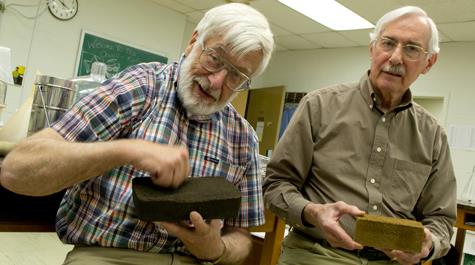As part of the ongoing effort to establish a human beachhead on the Red Planet, two veteran researchers in the US are on a quest to develop bricks from regolith, the term given to the peculiar dirt on Mars.
The idea behind the NASA-funded programme is that Mars settlers should be able to use locally-available materials to build structures to cut down on the cost of transporting them from earth.
But there is a special requirement for Martian bricks: they must be able to withstand lethal galactic cosmic radiation (GCR), which can penetrate everything from human DNA to electrical components.
No regolith samples are available on Earth, so, to create their extra-terrestrial building block, Robert Orwoll and Richard Kiefer, who are professors emeriti from Virginia’s College of William & Mary, are using what scientists believe is the nearest thing: rock from a volcano in Hawaii.
Think about hauling a bunch of construction stuff to Mars in a spacecraft! That just wouldn’t be possible– Prof Emeritus Robert Orwoll
A key challenge is to find the right formula for a polymer binding agent for regolith. In this, Orwoll and Kiefer are collaborating with a private firm, International Scientific Technologies (IST) of Radford, Virginia, which has received a small business research grant from NASA to help find ways to protect astronauts from space radiation.
Described as essentially cosmic shrapnel from supernova events, GCR comprises nuclei from hydrogen and helium atoms all the way up the Periodic Table to iron. With its minimal atmosphere and lack of magnetic fields, Mars offers scant protection from it.
“It’s a highly penetrating radiation, and very damaging, both to DNA and to electrical components on a space mission,” Robert Orwoll told the College of William & Mary news team.
“Radiation is a very serious problem for NASA,” he added. “You don’t read about it much in the papers, but they’ve got a ways to go yet on solving the radiation problem before they can send anybody to Mars.”
It means that the first humans on Mars will have to build shelters, and it will help if they can use the raw material already there.
“Think about hauling a bunch of construction stuff to Mars in a spacecraft! That just wouldn’t be possible,” said Orwoll.
“Even Home Depot isn’t there yet,” his colleague Richard Kiefer quipped.

Researchers Robert Orwoll, left, and Richard Kiefer with sample regolith-polymer bricks (Joseph McClain/College of William & Mary)
Orwoll is a polymer chemist, while Kiefer is a nuclear chemist. Both have worked on NASA projects involving lunar regolith and developing polymer radiation shielding.
The regolith substitute they’re using is quarried from the cinder cone of Pu’u Nene, a volcano in Hawaii. Scientists have been using it to prepare for Mars since 1998 because soil analyses done by various Mars missions suggest a match.
“There’s a lot of silicate, like sand, in regolith. There’s a lot of iron; that’s why it’s red,” Kiefer said. “It’s a combination of a lot of things, you know, just like dirt here on Earth. But regolith doesn’t have any organic material. It would be more like you find in a desert.”
Now, to find the best polymer binder for humans to bring Mars, they bake regolith-simulant bricks in their lab, often using cake tins from department stores.
The binder needs to mix easily and be an effective radiation shield, which means having a high hydrogen content. Hydrogen is better than lead as a radiation shield, and is much lighter.
As for making the bricks on Mars, Orwoll and Kiefer suggested that, in theory, robots could mass produce them years prior to humans arriving. But they admit this line of inquiry enters the realm of the speculative. For now, they’re focussing on the bricks.
Top photograph: Panorama of Mars’s Endeavour Crater, from photos taken by the Opportunity Mars Rover in 2011-12 (NASA/JPL-Caltech/Cornell/Arizona State U/Wikimedia Commons)
Comments
Comments are closed.











Relax! – Any type of space radiation can be debilitated to the point that it will be absolutely harmless to astronauts, for they can be Radiation-Proof and Immortal – I got a discovery (just an exercise for a minute a day) that will make them Infinitely Healthy and by that absolutely Radiation-Proof and Immortal in less than a month – My WVCD – The Weapon of Virus and Cancer Destruction – Doing it, I cannot get sick of any Infections, Cancers, Diabetes, Polio, TB, Allergies, Cardiovascular (any heart disorders are excluded), Cerebrovascular (any brain damages are excluded), Genetic, Autoimmune, Chronic, Radiation and any other diseases, known on Earth, for every cell of my body is shielded 100% from any external/internal (genetic) impact – I will describe my WVCD to everyone, who sends me an e-check for one million US Dollars – Doing my discovery for just a minute a day, everybody will stay absolutely healthy all the time, living their Endless Lives, for Infinite Health = Immortality – NASA and Elon Musk can rest assured – They and their astronauts will be Infinitely Healthy, Radiation-Proof and Immortal – Like the Gods who created us humans.